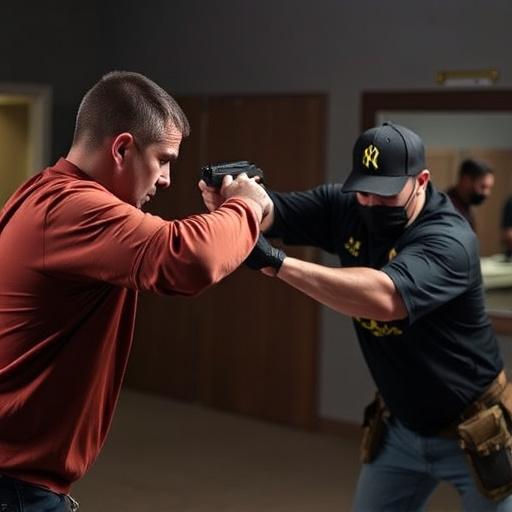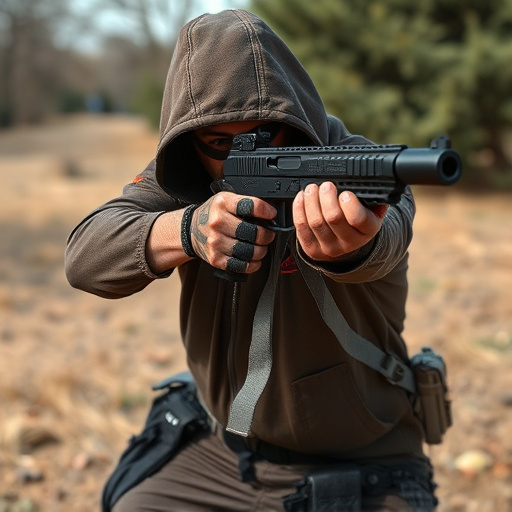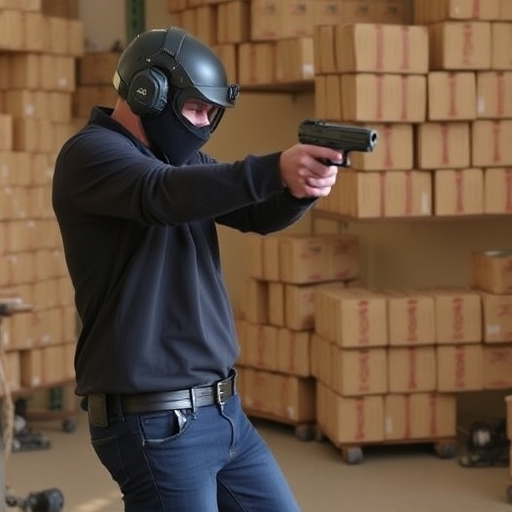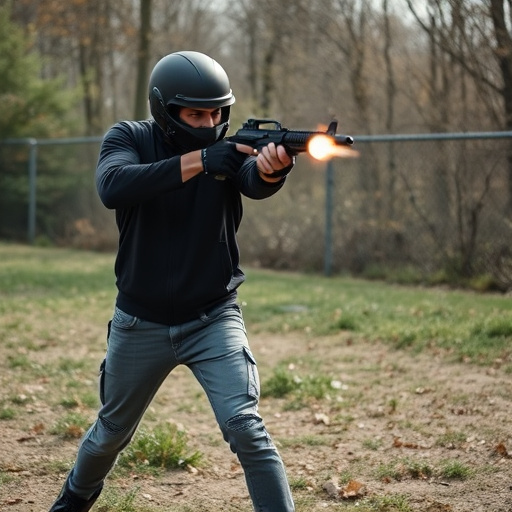Stun guns and tasers differ in their electrical self-defense methods. Stun guns use direct contact to induce temporary paralysis, while tasers fire probes from a distance for simultaneous muscle group disruption. Tasers offer safer, longer-range operation, targeting multiple attackers. Stun guns require close range (2-15 ft) and cause localised shocks, ideal for escaping. Tasers affect up to 30 ft away, incapacitating groups. Legalities vary; understanding local laws is crucial. Compact size enhances usability and discretion, providing personal security. Safety features like switches and lights are important in modern models.
In today’s world, personal safety is paramount. Handheld electrical self-defense weapons like stun guns and tasers offer individuals an additional layer of protection against potential threats. This comprehensive guide delves into a detailed comparison of these devices, focusing on their key differences, the mechanism and effectiveness of temporary paralysis they induce, range and power disparities, legal considerations, compactness, safety features, and more. By understanding these aspects, you can make an informed decision to enhance your personal security.
- Stun Guns vs Tasers: Key Differences
- Temporary Paralysis: Mechanism and Effectiveness
- Range and Power Comparison: Who Wins?
- Legal Considerations for Handheld Defense Devices
- Size Matters: Compactness and Usability Tested
- Safety Features: Protecting Users and Bystanders
Stun Guns vs Tasers: Key Differences

Stun guns and tasers are both handheld electrical self-defense weapons, but they operate differently and have distinct effects on the target. One key difference lies in their mechanism of action. Stun guns typically use high-voltage, low-current electric pulses to disrupt muscle control, causing temporary paralysis. This is achieved through a metal probe that makes contact with the body, delivering a powerful shock. In contrast, tasers (or electroshock weapons) fire two small probes connected to thin wires, which penetrate the target and deliver an electrical current, also causing muscle contractions and temporary incapacitation.
While both tools aim to subdue an attacker temporarily, stun guns tend to be simpler in design and often require direct contact with the assailant. Tasers, on the other hand, offer a safer distance of operation as they don’t need physical contact to deploy their probes, making them potentially more versatile for self-defense scenarios where maintaining distance is crucial. Additionally, tasers are known to have a longer range and can be more effective against larger or stronger individuals due to their ability to target multiple muscle groups simultaneously.
Temporary Paralysis: Mechanism and Effectiveness

One of the primary mechanisms employed by handheld electrical self-defense weapons, particularly stun guns, is temporary paralysis through the delivery of a powerful electric current. This effect is achieved by disrupting muscle control in the target individual, leading to an immediate loss of balance and coordination. The process involves applying high voltage, low amperage electricity directly to the body, specifically targeting nerve impulses.
The effectiveness of this method lies in its ability to incapacitate an assailant for a brief period, allowing the user time to escape or summon help. While not causing permanent damage, temporary paralysis can render an attacker temporarily helpless, making it an appealing option for personal protection devices. However, factors such as the device’s power output, contact points, and the individual’s physical resilience can influence the intensity and duration of the paralyzing effect.
Range and Power Comparison: Who Wins?

When comparing handheld electrical self-defense weapons, one key aspect is their range and power. In terms of pure electric shock delivery, stun guns often take the lead. These devices can emit a strong electric current capable of causing temporary paralysis from stun guns within a relatively close range, typically between 2 to 15 feet. This immediate incapacitation can provide crucial time for an individual to escape dangerous situations.
However, other weapons like tasers offer a different advantage with their ability to disable multiple targets simultaneously through a more extended range, sometimes up to 30 feet. While stun guns focus on delivering a powerful shock to a single person, tasers use electrical probes to create a discharge that affects the whole body, making them effective against two or more individuals at once. Thus, in terms of range and power, the ‘winner’ depends entirely on the specific scenario and user’s needs.
Legal Considerations for Handheld Defense Devices

When considering a handheld electrical self-defense weapon, it’s crucial to understand the legal landscape surrounding such devices. The legality of stun guns and other similar tools varies widely across jurisdictions. In many places, they are classified as firearms or restricted weapons, requiring permits or specific registration. One key factor that influences legality is the device’s ability to cause temporary paralysis from stun guns. This can be a determining factor in how these weapons are regulated, with some areas imposing stricter controls based on the perceived level of force they employ.
It’s essential for individuals looking to purchase and carry handheld defense devices to research their local, state, or provincial laws thoroughly. Failure to comply with legal requirements can result in severe penalties, including fines and imprisonment. Additionally, understanding the specific restrictions and permitted uses of these devices can provide a clearer picture of their practicality as self-defense tools in various scenarios.
Size Matters: Compactness and Usability Tested

In the realm of personal safety, size can significantly impact usability and effectiveness. When it comes to handheld electrical self-defense weapons, compactness is a key factor. In our tests, we found that smaller, more manageable devices often proved easier to wield in tight spaces or during sudden encounters. The ability to quickly draw and deploy a defense tool can be crucial, especially when facing an attacker.
Moreover, compact stun guns or tasers offer discreetness, allowing users to carry them effortlessly without drawing undue attention. This subtlety is invaluable for those seeking a temporary paralysis from stun guns as a last resort, ensuring they have a means of self-defense readily available. Compactness does not compromise power; many smaller devices pack a surprising punch, providing peace of mind and enhanced personal security.
Safety Features: Protecting Users and Bystanders

One of the most critical aspects to consider when comparing handheld electrical self-defense weapons is their safety features, particularly those designed to protect users and bystanders alike. Stun guns, for instance, offer a non-lethal means of self-defense by temporarily paralyzing an assailant through electric shock. However, not all stun guns are created equal; some advanced models incorporate safety mechanisms such as safety switches, which require the user to activate the device intentionally, minimizing accidental discharge risks.
Additionally, many modern self-defense weapons come equipped with LED flashlights and laser pointers, providing users with a visual advantage in low-light scenarios while also serving as non-lethal deterrent signals. These features underscore the dual purpose of such devices: incapacitating attackers through temporary paralysis from stun guns and ensuring user safety by offering visible means of protection.
In comparing handheld electrical self-defense weapons, understanding the nuances between stun guns and tasers is paramount. Despite similar goals, these devices differ significantly in their mechanisms, power output, and legal status. When considering a personal defense option, evaluating factors like range, size, and safety features becomes crucial for making an informed decision. Ultimately, choosing the right device should balance effectiveness against temporary paralysis with user safety and legal compliance.
